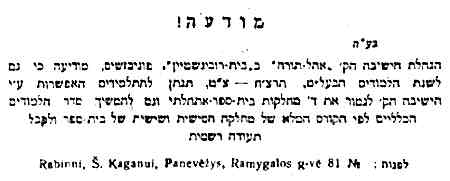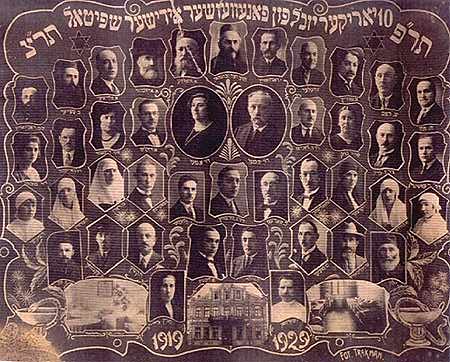In accordance with the "Autonomy Law for the Jews," issued by the new Lithuanian Government, a Community Committee of 24 members was elected in 1919: 2 members were elected from the list of Tseirei-Zion; 1-Mizrachi; 9 from "Achduth"; 2- artisans, 5- workers; 2- non party; 3- non defined. Elections to the Committee took place in 1921 and in 1923, when 4,812 people had voting rights.
The Committee was active through its various subcommittees in almost all fields of Jewish life from the middle of 1919 until February 1926. A total of 11 subcommittees were established as follows: education and culture, economy, administration, hospital, social help, childcare, religious issues, the cemetery, help for Pesach etc. There were also 4 temporary subcommittees for election work and other activities.
The funds for the Committee came from taxpayers’ money - there were 864 taxpayers - and from indirect payments such as donations for the Orphans’ Home, for the Hospital, "Contribution days" etc. Funds were also derived from different services the Committee offered, like: registrations of births, weddings, divorce, deaths etc. The Committee was also supported by the "Jewish National Committee" in Kovno and by natives of Ponevezh who settled in South-Africa (Johannesburg, Kronstadt, Capetown) and in America (NewYork, Chicago, Baltimore, Philadelphia) and organized their local associations in the above mentioned cities.
According to the first census the government carried out in 1923 there were 19,147 people, among them 6,845 Jews (36%): 3,227 males and 3,618 females in Ponevezh.
After the Community Committee was dissolved by the semi-fascist government that took over the rule in Lithuania, all its functions were transferred to the "Knesseth Yisrael Association" that continued to act as its predecessor. It had about 400 members who paid membership fees, but the committee did not have enough money to support the great welfare institutions like the Hospital, the Orphans Home and the Home for the Aged, therefore the Municipality contributed a part of the budget to these institutions.
The chairman of the council of "Knesseth Yisrael" was Dr. Jur. Shmuel Landoi. He was also the chairman of the management of the town’s "Folksbank" and the deputy chairman of "The Union of the Jewish Folksbanks in Lithuania" . In the elections for the Municipality Council that took place at the beginning of the twenties 12 Jews of 40 members of the Council were elected and among them the above mentioned Dr. Sh.Landoi. He was also the acting delegate to the "Founding Seimas" (Parliament) on behalf of the "Folkspartei". Naftali Fridman (1862-1921), who was also the delegate to the third and fourth "Duma" (The Russian Parliament) in the years 1907-1917 was an elected delegate to the Seimas. Another delegate to the Founding Seimas was Rabbi Yosef-Shlomo Kahaneman, who became the Rabbi of Ponevezh in 1919.
In the elections of 1931 only 7 Jews of 21 members of the Municipality Council were elected (A.Fleisher, A.Riklis, Adv. Shats, Adv. Landoi, Chazan, Ram, Z.Leibovitz). In the elections of 1934, 5 Jews among the 21 members that were elected. In these elections there were 1,576 Jews with voting rights among 6,766 people with voting rights (23%). For many years Avraham Fleisher was the Deputy Mayor.
The Jews of Ponevezh played an important role in the economic life of the town. They were leaders in trade and export of flax and grains and were owners of the great flour-mills ("Yakur", Rubinshtein, Lev and others) that supplied the greater part of the state’s total consumption of flour.
According to the governmental survey of 1931 there were 216 stores in Ponevezh and among them 163 were owned by Jews (75%). The division according to type of business is presented in the table below
|
Type of the business |
Total |
Owned by Jews |
|
Groceries |
18 |
14 |
|
Grains and Flax |
11 |
11 |
|
Butcher shops and cattle trade |
32 |
21 |
|
Restaurants and taverns |
19 |
7 |
|
Food Products |
22 |
21 |
|
Beverages |
4 |
4 |
|
Textile products and Furs |
19 |
18 |
|
Leather and Shoes |
23 |
21 |
|
Tobacco and Cigarettes |
2 |
1 |
|
Haberdashery and Home Utensils |
13 |
12 |
|
Medicine and Cosmetics |
9 |
7 |
|
Watches, Jewels and Optics |
7 |
4 |
|
Radio, Bicycles and Sewing Machines |
3 |
2 |
|
Tools and Steel Products |
5 |
4 |
|
Building Materials and Furniture |
5 |
2 |
|
Timber and Heating Materials |
4 |
4 |
|
Vehicles and Transportation |
5 |
1 |
|
Stationary and Books |
1 |
0 |
|
Miscellaneous |
14 |
9 |
According to the same survey there were 105 light industry factories and of them 71 owned by Jews (68%). The different businesses are presented in the table below:
|
Type of Factory |
Total |
Jewish owned |
|
Metal Workshops, Power Plants |
10 |
4 |
|
Headstones, Glass, Bricks |
1 |
0 |
|
Chemical Industry: Spirits, Soaps |
1 |
0 |
|
Textile: Wool, Flax, Knitting |
16 |
15 |
|
Timber Industry: Sawmills, Furniture |
4 |
2 |
|
Paper Industry: Printing Presses, Binderies |
3 |
3 |
|
Food Industry: Flour Mills, Bakeries |
39 |
26 |
|
Dresses, Footwear, Furs ,Hats |
26 |
17 |
|
Leather Industry: Production, Cobbling |
2 |
2 |
|
Barber Shops, Pig Bristles, Goldsmith |
3 |
2 |
Except for the merchants and the clerks, many Jews made their living from skilled occupations. In 1937 there were 263 Jewish skilled tradesmen: 70 tailors, 39 shoemakers, 21 butchers, 14 barbers, 14 tinsmiths, 9 bakers, 8 knitters, 8 painters, 8 tailors, 5 oven-builders, 5 glaziers, 5 milliners, 5 carpenters, 5 blacksmiths, 5 cobblers, 4 electricians, 4 corset makers, 4 bookbinders, 4 photographers, 4 watchmakers, 3 furriers, 3 leather workers, 3 dressmakers, 2 wood etchers, 1 printer, 1 locksmith, 1 textile painter and 8 others.
In 1939 there were about 300 members in the "Association of the Jewish Artisans" in Ponevezh. There were also Jews in independent professions but their number decreased during the years. In 1921 there were 15 doctors and of them 11 Jews (73%), in 1932 there were 27 doctors in town and of them 15 Jews (55%). In 1925 there were 12 Jewish dentists, 7 dental practitioners and several lawyers in town.
It should be mentioned that among the 25 clerks of the State Bank and among the 21 judges and the many court employees there was not a single Jew.
An important role in the economic life of the town was played by the Jewish "Folksbank". It was established before World War I and was called then "The Jewish Credit Bank". The "Folksbank" had 207 members in 1920, in 1927 - 1,123 members and in 1929 - 984 members. Other financial institutions of Ponevezh were "The Jewish Central Bank" that had only two branches, one in Ponevezh and the other in Kibart (Kybartai) ; "The Commerce Bank"; "Bank for Mutual Credit" and "Bank Elitsur". There was also the branch of "The United Association for Credit for the Jewish Agriculture in Lithuania" with its head office in Kovno. In 1938 the Association of the Small Store Owners established a Credit Fund for its members.
The drought that occurred in many regions of northern Lithuania in 1928-1929 caused many Jewish families to depend on welfare. It also brought on physical attacks on Jews in Ponevezh. There were also attacks on Jews in 1927.
The economic crisis of Lithuania at the beginning of the thirties and the propaganda of the Lithuanian Merchants Association (Verslas) against Jewish stores, hurt many Jewish families badly. The "Verslas" tried to attract clients by issuing "Blue Stamps" (Credit Stamps) and the "Jewish Merchants Association", issued "Green Stamps in defiance. Jewish Ponevezh was described then as "a poor town rich with institutions".
In 1939 there were 513 telephones in Ponevezh. 92 of them belonged to private Jews and to the Jewish education and welfare institutions.
In 1939 there were 26,653 people in town and of them 6,000 Jews (22%).
Education and Culture
There were three Jewish educational systems in Ponevezh: the Hebrew-Zionist, the Hebrew -Religious and the Yiddishist.
The Hebrew High School opened in 1920 with about 400 students from many towns of the northern part of the country. The school first opened in rented flats, not suitable for the purpose. The knowledge of the students in different subjects and in Hebrew was not substantial. There were no textbooks in Hebrew and no reference books for the teachers. Not all teachers were professionals, and there were the others who had difficulty to get used to the "Sephardic Pronunciation" accepted in Eretz-Yisrael.
There were conflicts between the parents of the students and the teachers, and much energy was wasted in endless meetings.
Only the third director of the High-School Adv. G.Gurevitz (after Dr. Mer and Dr. Rozenberg) managed to bring peace to the school, and it began to develop . Meanwhile an elementary Hebrew school was opened in a third rented flat. After getting annual support from the government and a free plot of land, a nice two story building was built, and in the autumn of 1928 studies at the school began . A very active person in the process of the construction was Zalman Rabinovitz (died in 1933).
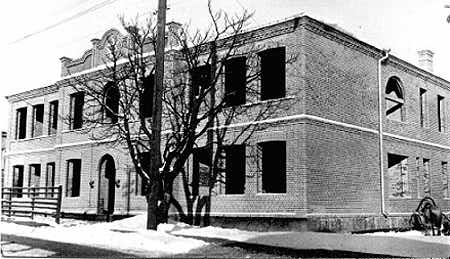
From 1927 Adv. Gurevitz was the official director, but the actual director was an invited Dr. Arthur Loewenhertz (the first director of the Hebrew High-School in Virbalis) who managed to bring order and strengthen the discipline in school. In 1929 he immigrated to Eretz-Yisrael (he later became the director of the High-School in Kiryath-Motzkin), and Dr.Yisrael Mehlman was the appointed director. In 1935 he and Adv.Gurevitz immigrated to Eretz-Yisrael and A.Leipziger was appointed as director. He managed to build a new wing to the school enlarging its capacity by 40%. It included a reading room, a physics laboratory and a big hall for sports and for different cultural activities. Then the long planned Hebrew Kindergarten was opened, and so the children spent 15 years of their lives in that building. From 1930 the Popular University opened in the same building as well.
In the winter of 1931 the national writer and poet Chaim. N. Bialik visited the High-School and this visit became a festivity for the whole Jewish population in town. From time to time other known Hebrew writers visited the school - Nachum Sokolov, Yitshak Lamdan, Zalman Shneur and others.

From right: Zalman Shilansky*, Dr. Yisrael Feld*,-----,Miriam Chatzkel (immigrated to Eretz Israel in 1935), Yasha -Ya'akov Levin (died in Israel),----,
Dr.Yitzhak Rozman (immigrated to Eretz-Yisrael in 1935), Yitzhak Shapira*, Yisrael Bekin*, Dr. Yitzhak Mehlman (immigrated to Eretz-Yisrael in 1935), Yitzhak Shreiber (died in Ponevezh in 1938).
Standing from right: Emanuel Sursky*, Shmeriyahu Oretzkin*
*--Murdered in the Holocaust
Nevertheless, the number of students in the High School declined. In 1929 the number of students was 200, and later the school had not more than 180 students, in comparison to the 400 in the first year of enrollment. The reasons for the decline were the establishment of a High-School for girls of the religious "Yavneh" network by Rabbi Yosef-Shlomo Kahaneman in 1928, and the propaganda of the Zionist youth organizations to join the "Kibbutzei Hachshara" (Training Kibbutzim) instead of studying for matriculation. Among the youth an idea became popular that the matriculation is not worth much, and that it is better to join a "Kibbutz Hachshara" and immigrate sooner to Eretz-Yisrael.
The "Yavneh" High School was accommodated in a building that was originally built on a donation for a 'Talmud-Torah" by a former Ponevezh Jew from South-Africa. This school competed with the other Hebrew High-School in the quality of teaching and tuition fees which were minimal.
The first class of the Hebrew High School graduated in 1924. There were 17 graduating classes of this High School through the years.


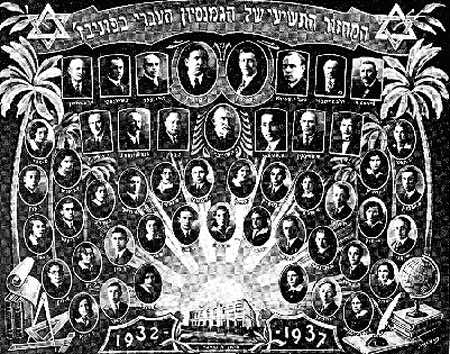
In addition to the above mentioned educational institutions in Ponevezh there was a Hebrew elementary school from the "Yavneh" network (Cheder haRav) with 350 students and a Yiddish Elementary school with 150 students, established in 1918.
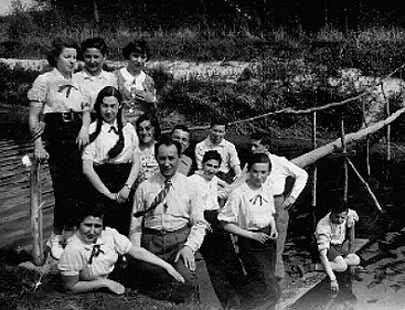
The eighth (graduation) class on a excursion near the river Sanzhila (a tributary of the Nevezys), summer 1938.
First line from right: Eliezer Aizenbud (near the water)-lives in Israel; Grinberg **; Moshe Yaffe-died in Israel 1979; Teacher Zalman Shilansky**; Liusia Shmutkin** (lying);
Second line: Aryeh Gordon**; Shimon Bekin-died in Israel; Eliyahu Lofert**; Shulamith Pliatzkin**; Chaya Rapaport**.
Third line: Rivka Volk-lives in South Africa; Yocheved Vexler -died in Israel 1997; Devorah Paleyes**.
** Murdered in the Holocaust

Meeting of the two graduation classes from Ponevezh and Shavl Hebrew High Schools together with the teachers and several public workers 1938, which took place according to the tradition of hundred days before the final examinations.
From the 47 people appearing on the picture, 22 were murdered in the Holocaust, 9 immigrated to Israel, 8 lived in Lithuania and other countries, the fate of 8 being unknown (see below).
